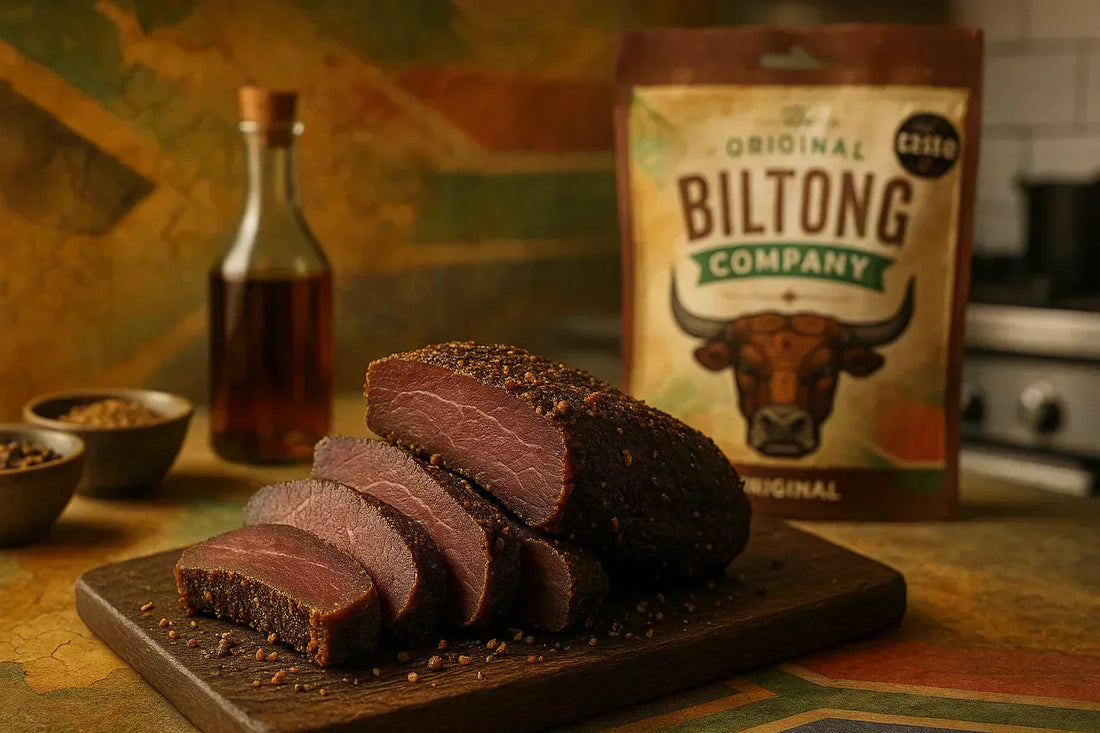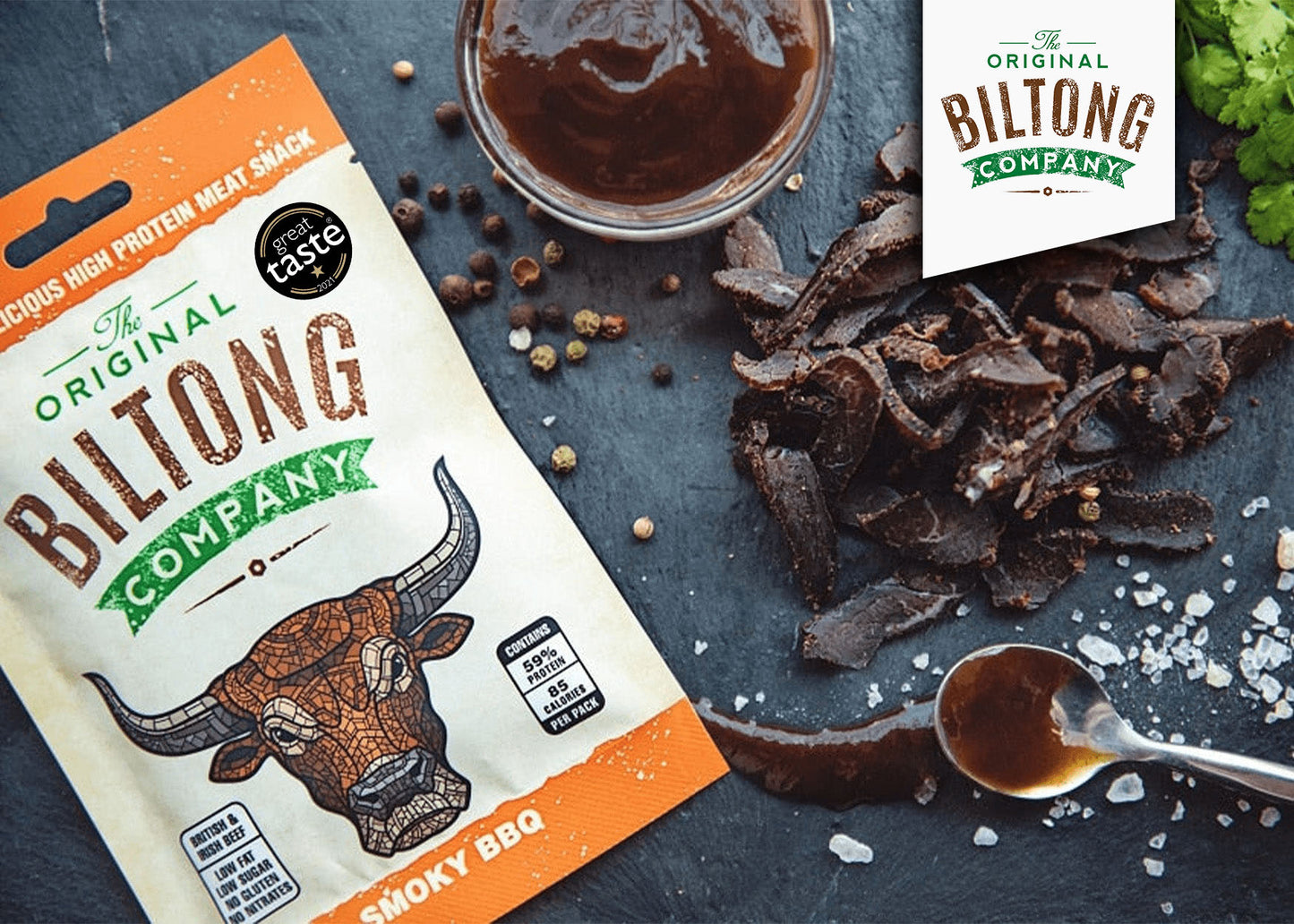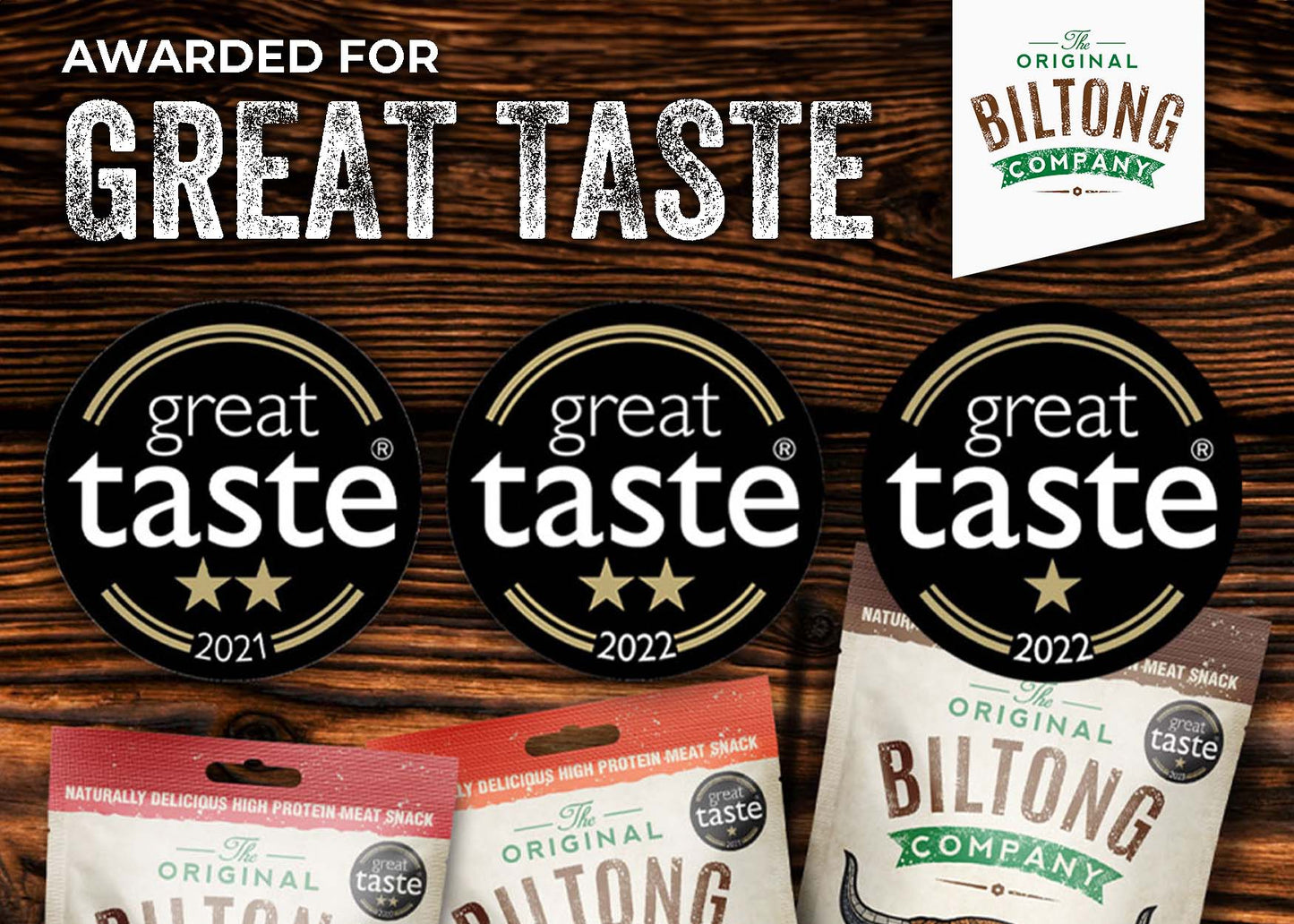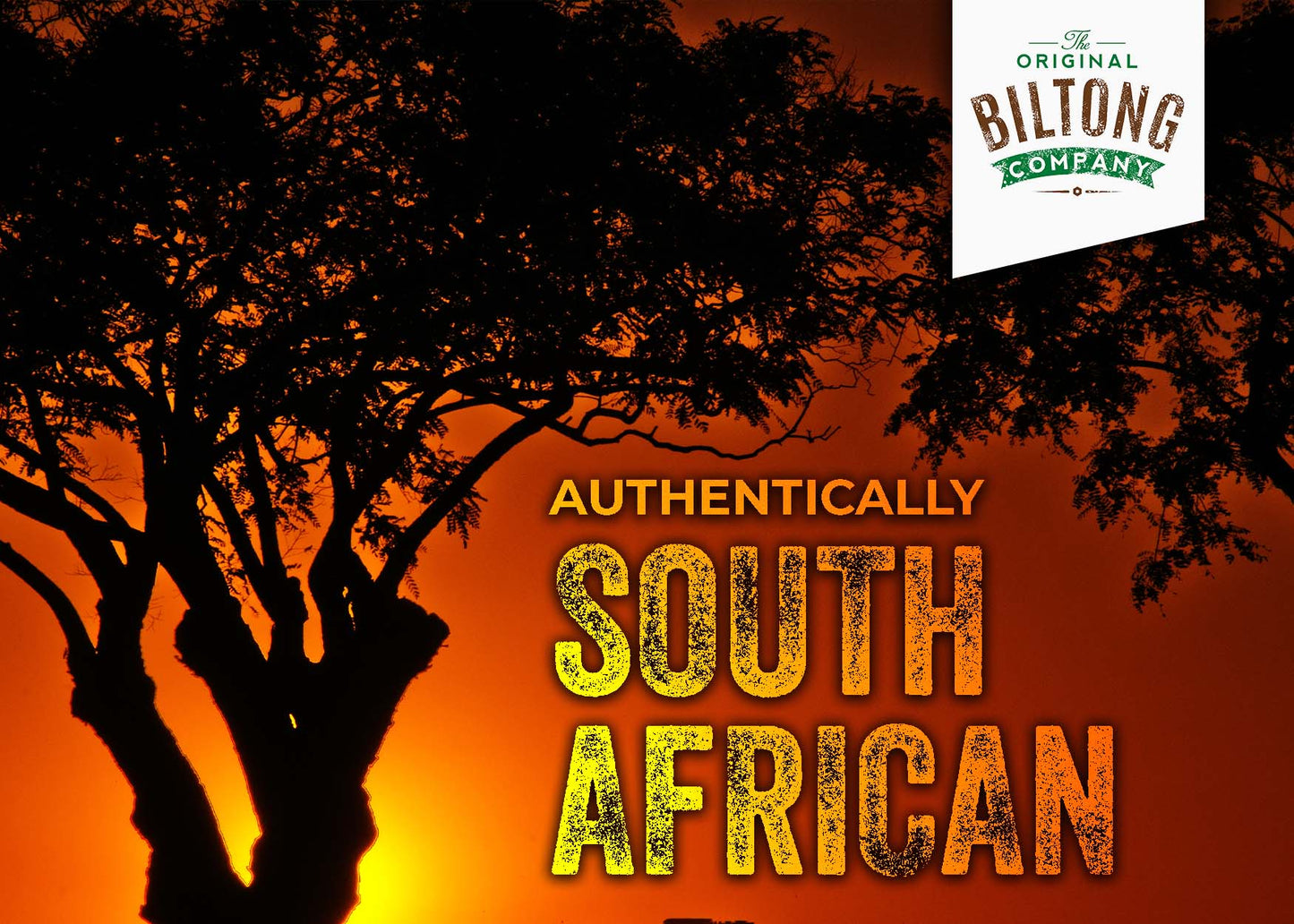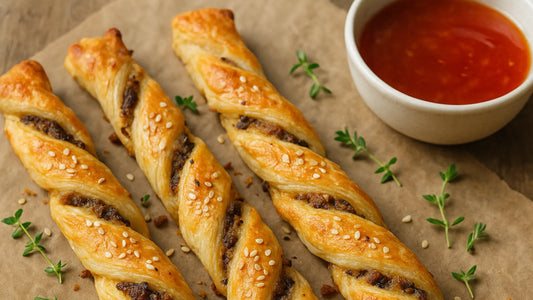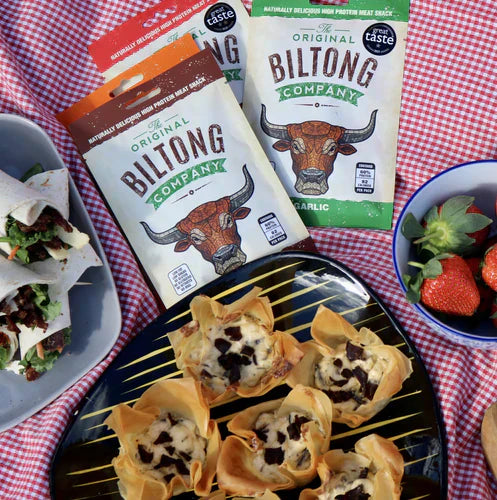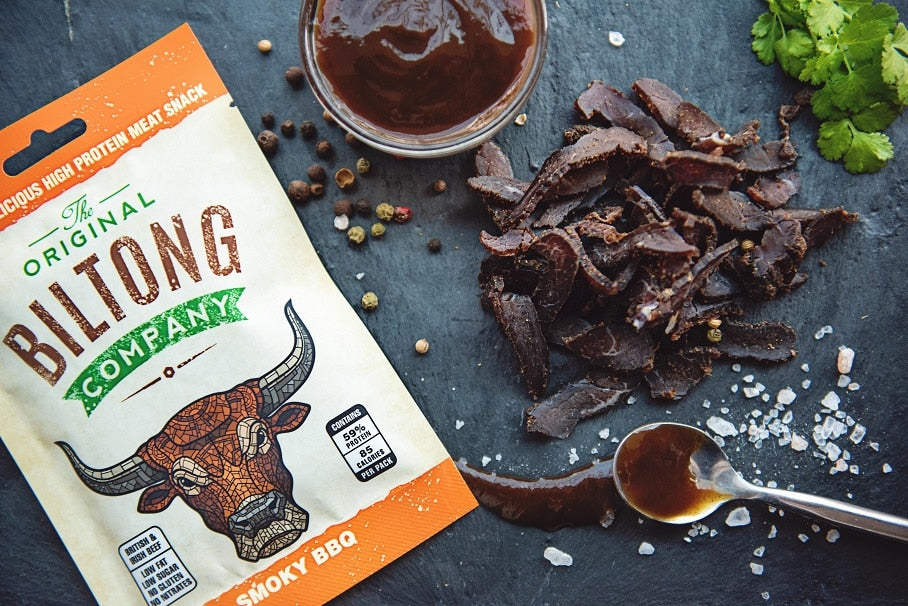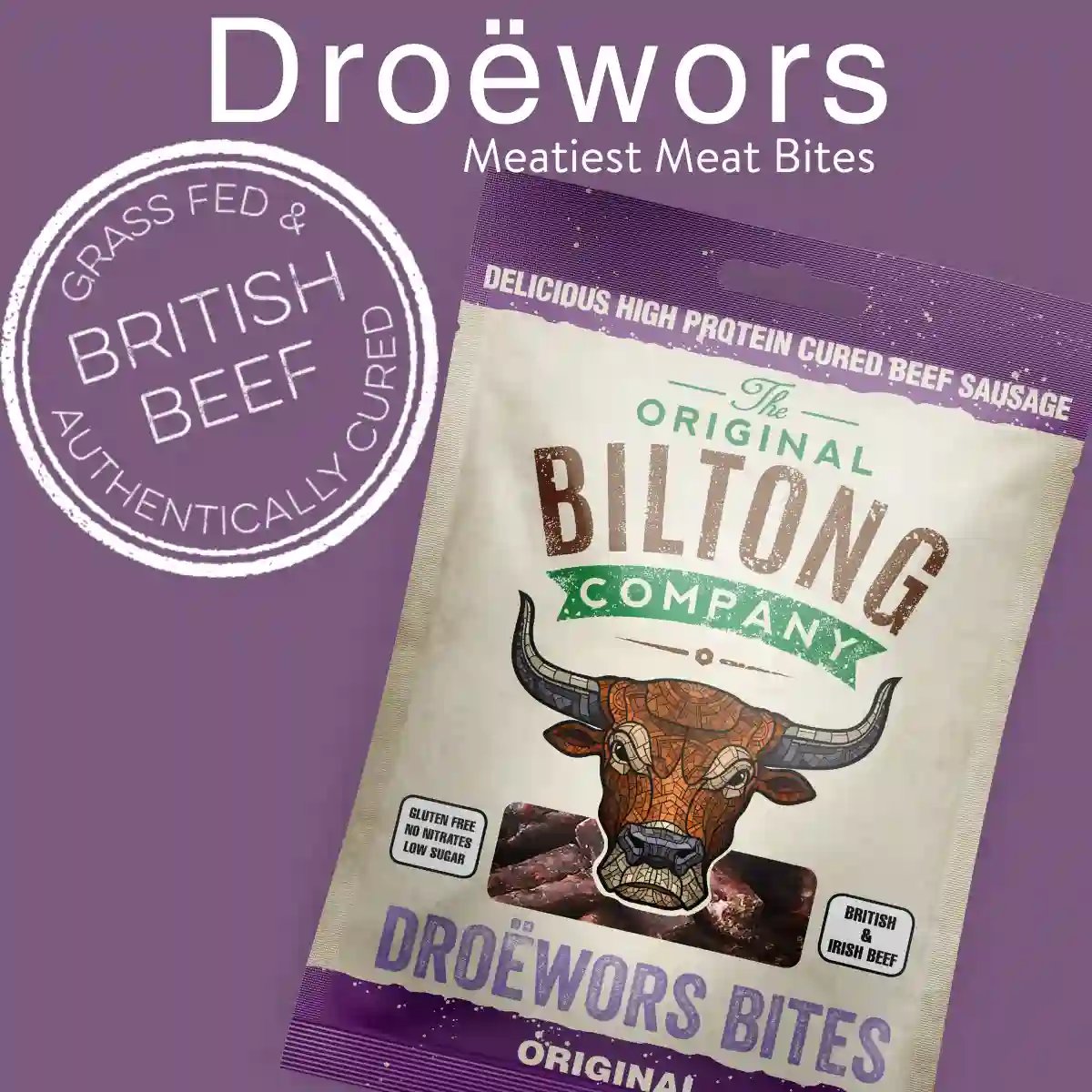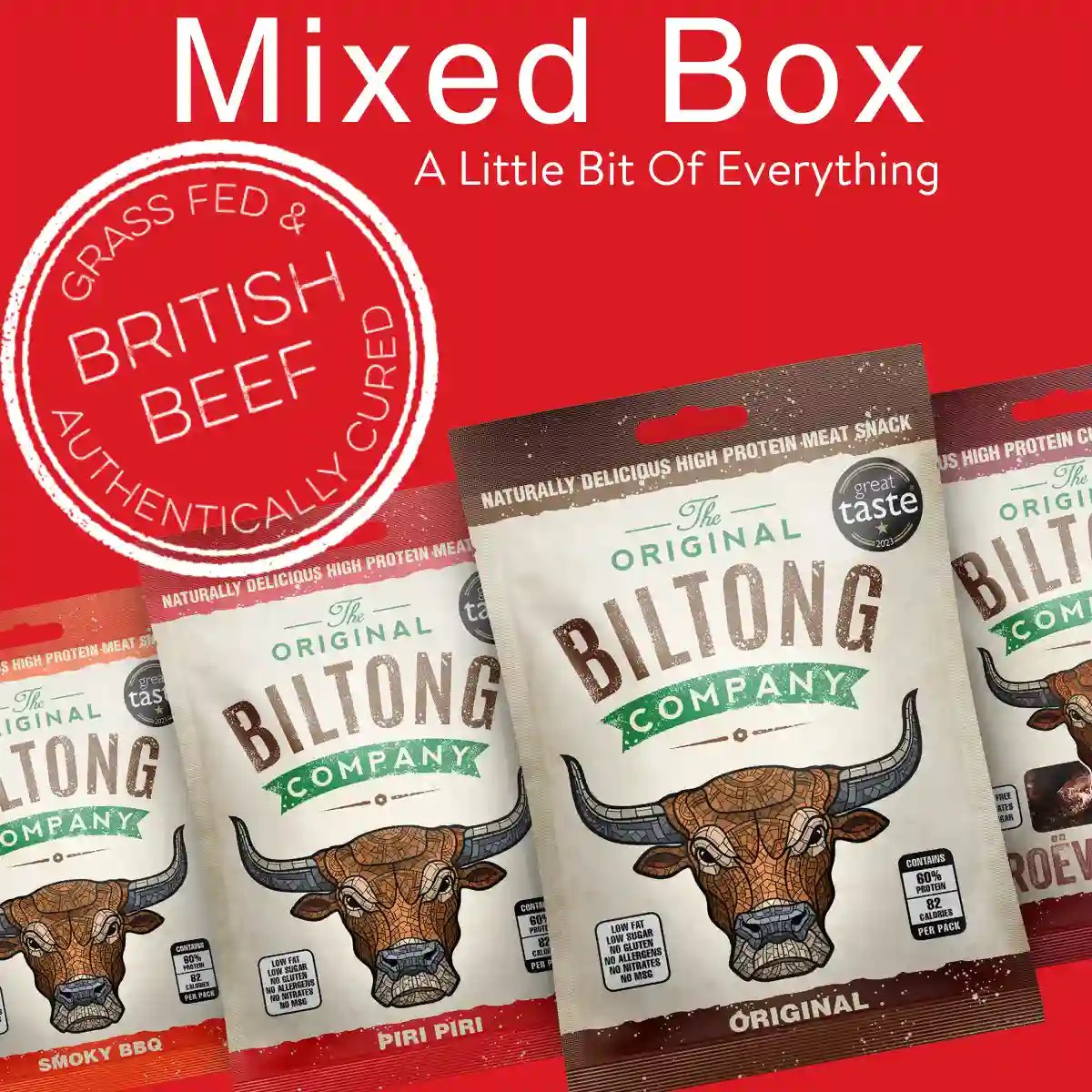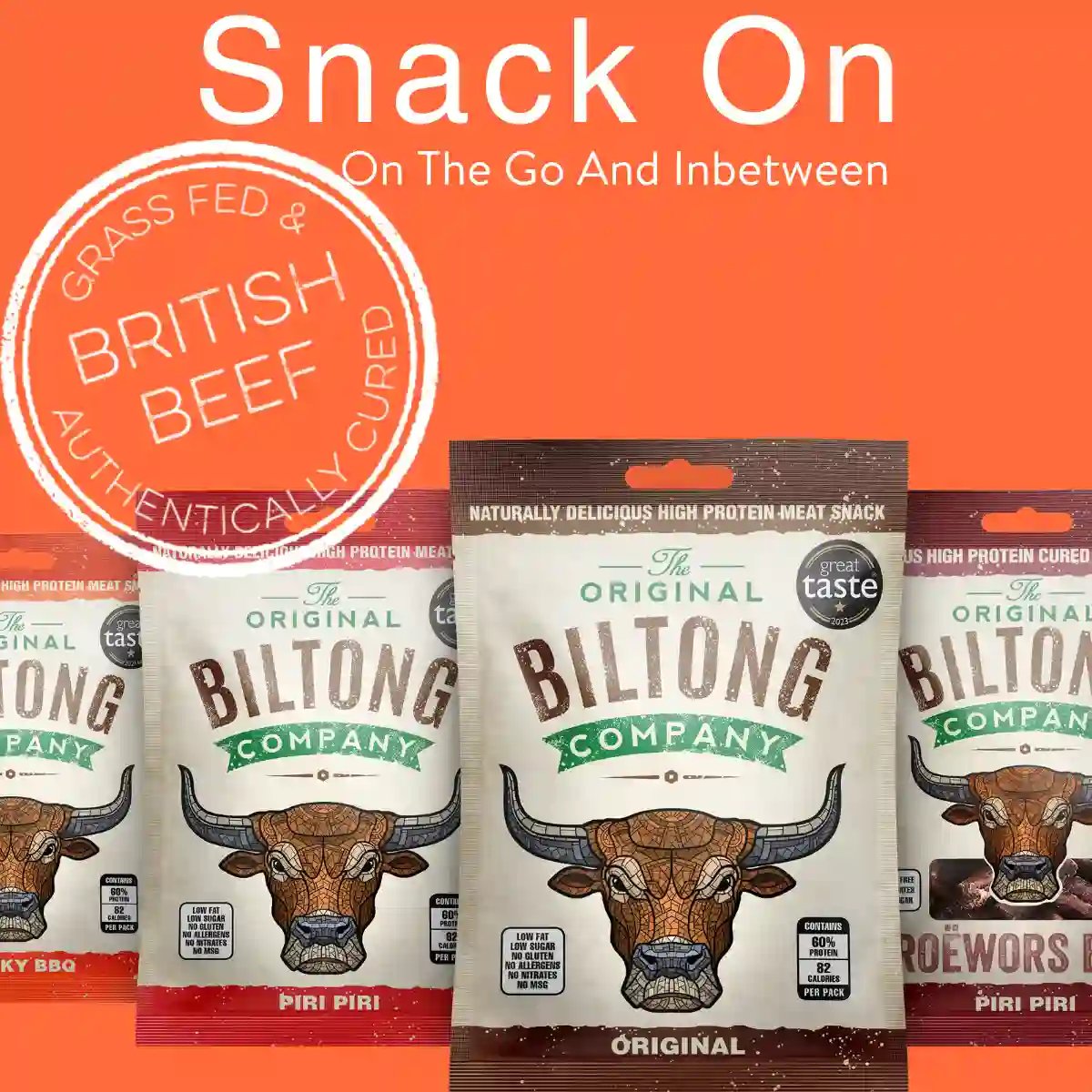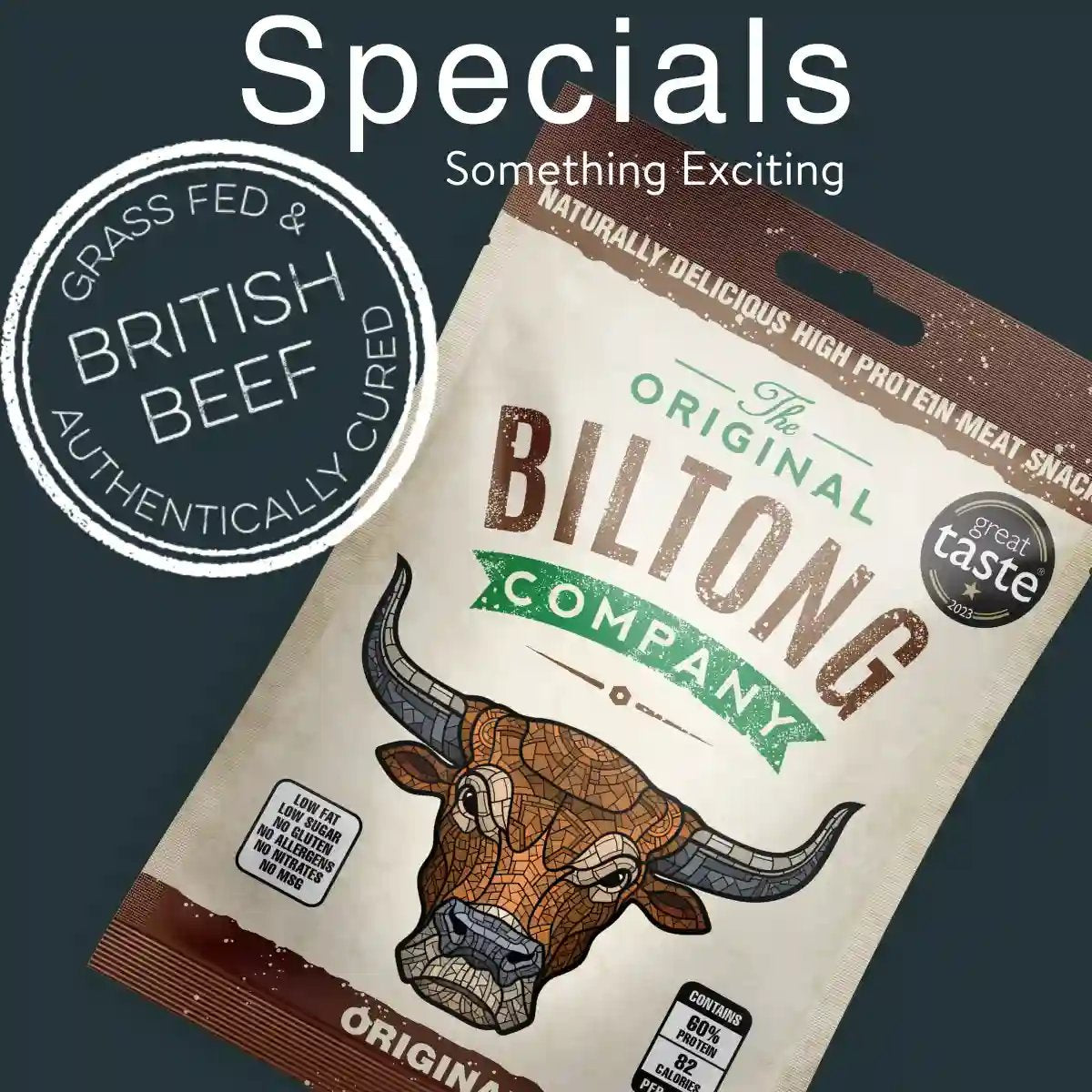Biltong is more than just a snack; it’s a mouthwatering experience rooted in South African culinary tradition. There are many types of biltong available today. These include traditional beef and game meats, such as ostrich and venison. This tasty African snack is high in protein and low in carbs. Thanks to the variety of biltong types, it’s gaining popularity among people seeking healthy options.
Key Highlights
-
Biltong is a traditional South African snack. It is made by air-drying slices of meat, like beef. The meat is seasoned with vinegar, salt, and spices.
-
It’s known for its tender texture, bold flavour, and high protein content.
-
Not the same as beef jerky — biltong is cured and air-dried, not cooked or smoked.
-
Now loved in the UK, beef biltong is a quick snack, gym fuel, or charcuterie staple.
-
Looking for biltong nutrition info? Check out our full health-focused blog here.

So, What is Biltong Meat?
Biltong is a traditional South African snack made from air-dried, cured strips of lean meat. Unlike cooked or smoked snacks, biltong is preserved naturally using vinegar, salt, and spices.
At The Original Biltong Company, we use only grass-fed British and Irish beef. This ensures a fully traceable and ethically sourced product. The result is a high-quality snack that’s as nutritious as it is flavourful — perfect for clean eating and protein-rich diets.
What Does Biltong Taste Like?
Biltong has a bold, savoury flavour with a tangy edge from its vinegar-based cure. It’s rich in umami, slightly spiced, and has a tender, chewy texture that sets it apart from jerky.
The quality of the meat shines through in every bite. Our curing process enhances deep, complex flavours without overpowering the beef’s natural taste. Whether you're new to it or a long-time fan, biltong is a unique taste experience worth trying.
The History of Biltong and How It’s Made
Biltong making began in the 17th century. South African travellers and farmers needed a way to preserve strips of meat without refrigeration.
They would cure very lean cuts in vinegar and salt, then air-dry them in cool, dry air conditions. This allowed the meat to develop a rich flavour while gaining a naturally long shelf life.
This method wasn’t just practical — it was smart. It relied on simple ingredients and sustainable food preservation. Over time, the technique was passed down through generations and remains in use today.
The Food and Agriculture Organisation (FAO) states that air-drying meat remains vital and sustainable in many cultures. This method remains prized in modern production around the world.
The Ingredients That Make Biltong Unique

At its core, real biltong is all about keeping it simple.
Common Meats:
-
Beef biltong: The most popular type, made from very lean cuts like silverside or sirloin.
-
Ostrich: Lean, slightly gamey flavour and rich in protein.
-
Venison: Includes meats like kudu or impala, offering a bold, earthy taste.
-
Springbok or wildebeest: Traditional in southern African countries, prized for their strong, gamey flavour.
Key Seasonings:
-
Coriander: Adds a citrusy warmth.
-
Black pepper: A subtle kick.
-
Salt: For curing and depth.
-
Vinegar: Essential for flavour and preservation.
This mix of vinegar and spices sets biltong apart from other cured meats. Traditional spice blends like these are used for both taste and preservation (European Food Information Council (EUFIC)).
Common Meats Used in Biltong
Biltong can be made from various types of meat, each with its unique flavour. Beef is the most common choice, especially lean cuts of meat. Due to South Africa's rich culinary heritage, game meat is also a popular choice. For example, an ostrich is another favourite snack. It adds a lean and lightly gamey flavour to biltong.
Some producers have also begun offering chicken biltong, which provides a lean, mild-flavoured alternative. It has a richer and stronger flavour. Ultimately, the choice of meat depends on personal preference and local traditions.
This variety allows biltong fans to enjoy different flavour profiles while savouring this well-loved South African snack.
The Making of Biltong: A Step-by-Step Guide

Making biltong is both an art and a science, rooted in tradition but refined through generations of experience.
Here’s how the process typically unfolds:
- Start with very lean cuts, such as silverside or sirloin.
- Slice the meat along the grain into thick fillets of meat.
- Soak the pieces in a mixture of vinegar and spices, allowing flavour to penetrate.
- Hang them in a dry, ventilated area, ideally in cool, dry air conditions.
- Wait 4–7 days, depending on the thickness of the meat and humidity levels.
Every step of the way, texture and flavour are developed slowly. Biltong doesn’t need heat, nitrates, or artificial preservatives. It’s made with just air, time, and simple ingredients to create something special.
-
Curious about meat safety during the drying process? The UK Food Standards Agency provides practical information on safe meat handling and curing methods.
-
Curious about meat safety during the drying process? The UK Food Standards Agency provides practical information on safe meat handling and curing methods.
-
Want to know how to store it once you’ve got it home? Read our biltong storage guide here.
How Biltong is Dried and Cured

Drying is the heart of the process. Once marinated, the meat hangs in dry air. This usually happens at a temperature between 15°C and 25°C. There is no heat and no additives—just nature doing its work.
Unlike jerky, which can be brittle, biltong stays moist and chewy. This texture boosts its flavour and makes it especially enjoyable.
Tips for Perfecting the Texture

Achieving the perfect biltong texture depends on your personal preference. Some enjoy lean, dry cuts, while others prefer fatty biltong for its rich, juicy mouthfeel.
Pro Tip
Check your biltong often while it dries. If you gently squeeze it, you can feel how dry it is. It should be firm but still slightly soft, indicating the ideal moisture level.
In the end, making your biltong means you control everything. From choosing the meat to deciding the drying time, you can create a great and personalised snack experience.
Why Biltong Is Taking Over Snack Shelves
Biltong might be new to some in the UK, but it’s long been a staple in South African cuisine.
Biltong is a dehydrated meat snack that's high in protein. It's also a fun addition to a cheeseboard. Biltong is popular in Britain for its simple ingredients and clean nutrition. The BBC’s World Cuisine section notes that biltong is now part of modern UK culinary trends.
Biltong vs Jerky — Key Differences in Taste and Texture

Although often compared, biltong and beef jerky are distinct.
Additional InformationWant to learn more about traditional vs modern meat processing? Check out the British Meat Processors Association (BMPA) for a breakdown of curing techniques and safety standards.
Nutritional Comparisons
Biltong is often regarded as a healthier alternative to many processed snacks. This is because it has high protein content. People looking to boost their protein or stay full like it a lot.
Biltong is also low in carbs and typically has minimal fat, especially when made with lean cuts of meat. This makes it a suitable snack for those following special diets, such as low-carb or ketogenic plans.
Biltong is a more natural and less processed snack, making it a tasty and nutritious option. It is often compared to jerky, which has added sugar and preservatives.
Why Biltong in the UK Is Becoming So Popular
More Brits are switching to biltong as they discover its nutritional benefits and culinary versatility. Whether on a hike, during a gym session, or with a drink, beef biltong fits modern eating habits.
Add it to salads, cheese boards, or eat it straight from the bag. Its delicious flavours and clean profile make it one of the best meat snacks you can buy in the UK today.
How to Eat and Serve Biltong

Here are some popular ways to enjoy it:
-
On a charcuterie board — pairs beautifully with creamy cheeses and tangy pickles.
-
As a post-workout snack — high in protein, low in fuss.
-
Mixed into a salad or wrap — adds a bold, meaty boost.
-
Alongside cheeses and nuts — a natural fit on any grazing platter.
-
Straight from the bag — soft, chewy, and flavour-packed on its own
Many people love the simple pleasure of biltong. Some cut it into smaller pieces to make it easier to nibble, while others enjoy its bold, chewy texture whole. However you slice it, thin-sliced biltong adds protein and a notch of flavour to nearly anything.
Ultimately, you decide how you eat biltong. It’s a delicious, protein-rich snack that can be enjoyed in many ways.
Where to Find Quality Biltong in the UK
Finding good South African biltong in the UK is now much easier. Its widespread availability in recent years demonstrates its growing popularity. Supermarkets often have a special section for biltong and other dried meat snacks.
If you want authentic South African biltong, speciality shops offer a variety of brands and flavours. These shops let you try different cuts of meat and spice blends. This way, you can find your perfect biltong.
You can also check out many online stores that deliver high-quality biltong to your home. This provides convenience, allowing you to enjoy the authentic taste of biltong.
Fan Favourites: Our Most Sought-After Biltong
Whatever your flavour preference, our range of different biltong flavours ensures there’s a delicious variety to suit every taste.
1. Original Biltong
The classic, must-try! Made with high-quality beef, this is our go-to choice for those seeking traditional beef biltong.
2. Traditional Original Biltong
Similar to the original, but cut into larger pieces or slabs. The larger cut provides a more rustic texture and a slightly chewier experience.
3. Piri Piri Biltong
Adds a spicy kick to our traditional biltong recipe.
4. Traditional Piri Piri Biltong
The spicy kick, but with a large, flavourful cut.
5. Garlic Biltong
Garlic lovers rejoice! This biltong infuses savoury garlic flavour into every bite.
6. Traditional Garlic Biltong
The tasty garlic flavour with a traditional larger cut is a popular choice.
7. Smoky BBQ Biltong
A smoky taste that perfectly complements the savoury biltong.
8. Traditional Smoky BBQ Biltong
Infused with rich smoky flavour in a traditional cut.
9. Big Taste Box
A selection of our delicious snacks and a great option to experience everything!
10. Original Droewors Bites
Tasty, small bites of cured sausage, perfect for a quick snack.

